

Sculptor: Philip Jackson
Unveiled 9/5/1995

The Liberation Sculpture was probably the most controversial work of public art put up in Jersey in the 20th Century. The design changed radically in response to fierce public criticism, and as usual questions of cost played their part in the the public debate.
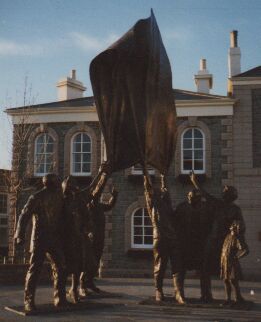

| At this place on 9th May, 1945, advance parties from the Royal Navy and the British Army liberated Jersey from nearly five years of occupation by German forces. They and the return of the British flag were greeted by thousands of Islanders with intense relief, joy and gratitude.
On the 50th Anniversary of that day,
This Sculpture by Philip Jackson F.R.S.S. |

When the design was unveiled by the Occupation and Liberation Committee of the States of Jersey, public opinion was generally one of astonishment that a line of figures were shown releasing a number of doves of peace.

The Committee explained that they had decided to change the brief to commemorate fifty years of peace.
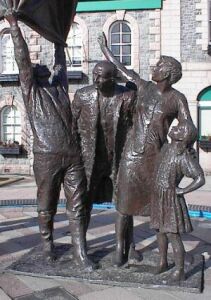
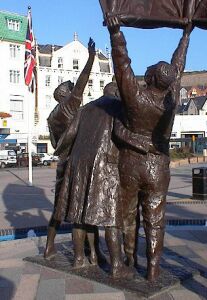
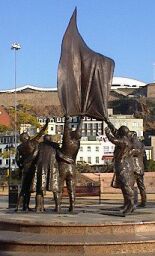
The public however had been anticipating a sculpture to represent fifty years since the Liberation.

And it was pointed out that if any doves had been around at the end of the Occupation, they would probably have been caught and eaten by the hungry population, rather than released.
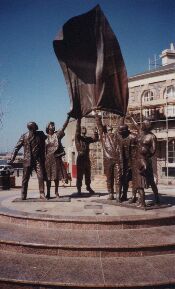
Many people commented that there was no recognition of the military aspect of the Occupation. Although the suggestions of some that an armed British soldier should be depicted defeating the German occupiers went perhaps a little too far for most.

The rear figure is, therefore, a subtle serviceman in battledress and boots.

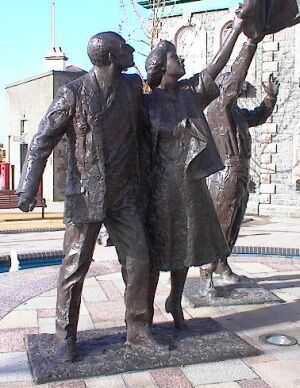
Another criticism of the initial design was the uninvolved rôle of women. The revised design has women playing a more central part in proceedings.
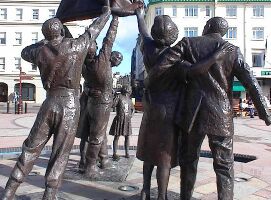
The original design did not allow interaction, but criticism was taken on board and the revised version allowed public participation - the spectator can walk through and join the figures in an almost theatrical way. Unfortunately the separate design for the dais was not altered to take this movement into account and crowds are always in danger of falling into the water.
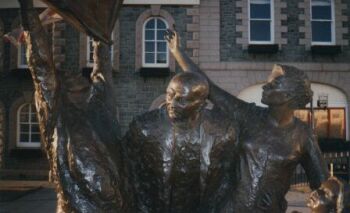
In the face of fierce criticism, the artist revealed that his original idea had been in fact to have the figures waving a flag - much more in tune with the public's understanding of the experience of Liberation - but the Committee had decided to change the brief to one of "peace", and so therefore the dove motif had been introduced.
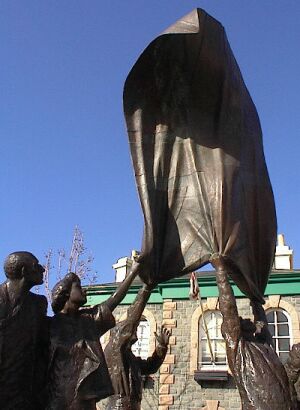
It was almost with relief that the revised design was seen to incorporate a giant Union Jack - although there were some comments about "hanging out washing".
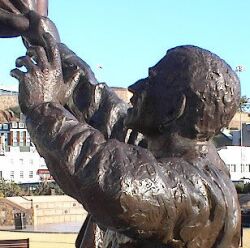
Revised Liberation sculpture approved
The revised design of the controversial Liberation Square statue was accepted by the House.
Since the last debate a month ago, the Occupation and Liberation Committee had gone back to the sculptor, Philip Jackson, the Jersey Sculpture Trust which commissioned the art piece and the pressure group led by Ron Skinner who were objecting to the design, said president Senator Jean Le Maistre.
The sculpture now depicts the moment when the status of the Island changed from occupation to liberation. he said, as a mark of gratitude for that momentous event and also the prosperity the Island has enjoyed since then.
JEP 29/9/1993
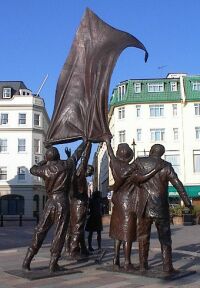
Statue of Liberty
As the Prince of Wales stepped forward to unveil the Island's Liberation sculpture, the crowd held its breath.
After the controversy over its placing, style and financing, the Islanders - who needed to be pleased because it was they who had experienced the rigours of the Occupation and the joy of Liberation - were to see it in its entirety for the first time.
Before taking his place on the plinth and unveiling the £150,000 bronze sculpture, the Prince of Wales had spent some time talking to the creator, sculptor Philip Jackson, who pointed out to him the 12 small fountains, each representing a parish of the Island.
The Dean of Jersey, the Very Rev John Seaford, then blessed the square and the sculpture, saying: 'We pray for God's blessing on this statue today. Almighty God, you have overcome the powers of darkness and you have set us free forever by the cross of Christ. Bless, we pray, this sculpture fashioned in thanksgiving for the Liberation of Jersey, and to remind us of our liberty today. May this place be always dedicated to the future peace of the Bailiwick.'
The work, unlike the arrival of the original maquette, which was greeted with dismay by some Islanders and subsequently altered, met with the crowd's approval. As soon as the official programme ended and the Prince moved away to his next engagement, to view the Liberation Tapestry, those in the stands behind, who had only been able to see the back view of the sculpture, flocked forward to see the faces of the seven Forties-style figures, which include a British Tommy, as they wave a Union Jack which is threatening to fly from their grasp.
Mr Jackson is reported to have said that he had spaced the figures so that children could walk between them and certainly, as the bulk of the crowd moved off towards the Royal reception, Islanders and visitors alike surged forward to take their place on the plinth to have their photographs taken.
JEP 10/5/1995
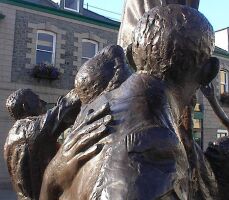
In the few years since its inauguration, Liberation Square in St Helier has come to play a major part in the social lives of many of the young people of Jersey, who gather there at night in great numbers. By day, the square is an early stop-off for thousands of holidaymakers from all over the world as they call at the Tourism Department. Poignant and uplifting at any time of day or night, the Liberation Sculpture unveiled five years ago has rapidly earned a place among the most popular of Island icons with both residents and visitors.
JEP 8/5/2000
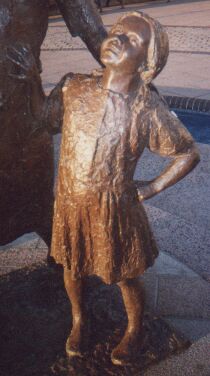
Liberation Square is now one of the best-used gathering places in St. Helier - especially for young people.

